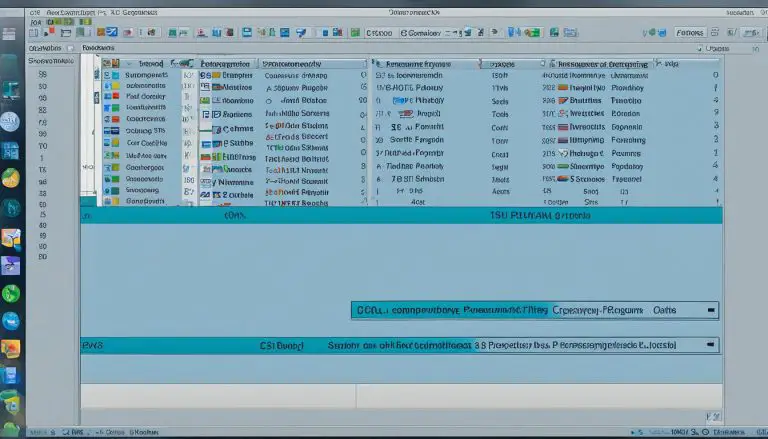Understanding: What is an Interpreted Language Explained
In the world of computer programming, there are two main types of programming languages: compiled and interpreted. An interpreted language is a programming language that is executed line by line, with each line being translated and executed by an interpreter. This means that the source code is not directly translated into machine code by the target machine. Instead, an interpreter reads and executes the code. Interpreted languages include popular languages such as PHP, Ruby, Python, and JavaScript.
Key Takeaways:
- An interpreted language is executed line by line with the help of an interpreter.
- Popular interpreted languages include PHP, Ruby, Python, and JavaScript.
- Interpreted languages offer flexibility and ease of use.
- Code written in an interpreted language is not directly translated into machine code.
- An interpreter reads and executes the code.
Interpreted Language Examples
Interpreted languages are widely used in various domains of software development. Here are a few examples of popular interpreted languages:
- PHP: Primarily used for web development, PHP powers a significant portion of the internet. It is known for its flexibility and extensive support for databases and web frameworks.
- Ruby: A dynamic, object-oriented language, Ruby is commonly used for building web applications. It emphasizes simplicity and readability, making it a favorite among developers.
- Python: Renowned for its simplicity and versatility, Python is a powerful interpreted language used in a wide range of applications, from web development to data analysis and machine learning.
- JavaScript: An essential language for front-end development, JavaScript enables the creation of interactive websites and web applications. It is executed directly in the browser, making it an integral part of the modern web.
These interpreted languages offer developers diverse options to tackle different programming tasks. Whether it’s building dynamic websites, automating tasks, or implementing complex algorithms, these languages provide powerful tools and libraries to get the job done efficiently.
As the demand for web and software development continues to grow, the use of interpreted languages like PHP, Ruby, Python, and JavaScript remains prominent in the industry. Their flexibility, ease of use, and extensive community support make them valuable assets for developers.
Furthermore, many popular frameworks and libraries have been built around these languages, further expanding their capabilities and facilitating faster and more efficient development. The rich ecosystems surrounding these interpreted languages allow developers to leverage existing resources and build high-quality software with ease.
| Interpreted Language | Primary Use |
|---|---|
| PHP | Web development |
| Ruby | Web application development |
| Python | Web development, data analysis, machine learning |
| JavaScript | Front-end web development |
These interpreted languages, with their unique features and strengths, continue to shape the landscape of modern software development, empowering developers to create innovative solutions that power our digital world.
Interpreted Language vs Compiled Language
In the world of programming, there are two main types of languages: interpreted and compiled. Understanding the difference between these two types of languages is crucial for developers to make informed decisions when choosing the right programming language for their projects.
An interpreted language, as the name suggests, is executed line by line by an interpreter. This means that the source code is translated and executed on the fly, without the need for a separate compilation step. On the other hand, a compiled language requires the source code to be compiled into machine code before it can be executed. This compilation process converts the entire source code into a binary format that can be directly executed by the computer’s hardware.
Key Differences:
- Translation Process: In an interpreted language, the code is translated and executed line by line, whereas in a compiled language, the entire code is translated into machine code before execution.
- Flexibility: Interpreted languages offer more flexibility as they allow for modifications to the code while the program is running. Compiled languages, on the other hand, offer less flexibility as the code needs to be recompiled each time a change is made.
- Execution Speed: Compiled languages generally have faster execution speeds compared to interpreted languages because there is no need for translation at runtime.
- Hardware Control: Compiled languages provide more control over hardware aspects such as memory management and CPU usage, whereas interpreted languages handle these aspects automatically.
It is important to note that there is no definitive answer as to which type of language is better. The choice between an interpreted and compiled language depends on various factors such as the project requirements, performance needs, and developer preferences. Some developers prefer the flexibility and ease of use offered by interpreted languages, while others prefer the efficiency and control provided by compiled languages.
Ultimately, understanding the differences and advantages of each type of language allows developers to select the most suitable language for their specific projects, ensuring optimal performance and efficiency.
Advantages of Interpreted Language
Interpreted languages offer several advantages that make them attractive to developers. One of the key advantages is their flexibility. Interpreted languages allow for dynamic typing, which means that variables do not need to be declared with specific types. This makes it easier and faster to write and modify code, as the interpreter automatically determines the variable types at runtime. This flexibility also extends to the ability to modify the code while the program is running, which can be useful for debugging and prototyping.
Another advantage of interpreted languages is their smaller program sizes compared to compiled languages. Interpreted languages typically have shorter code files, which can lead to quicker development and easier maintenance. Additionally, the interpreter itself is often lightweight and does not require extensive system resources, making it easier to distribute and execute programs written in interpreted languages on different systems.
Furthermore, interpreted languages are platform independent, which means that the same code can be executed on different systems without modification. This is particularly beneficial for web development, as it allows developers to create cross-platform applications that can run seamlessly on various operating systems. With the increasing popularity of mobile and web applications, the platform independence provided by interpreted languages is a significant advantage.
Overall, the advantages of interpreted languages, such as flexibility, smaller program sizes, and platform independence, make them a popular choice for many developers. However, it is important to weigh these advantages against the specific requirements of a project and consider factors such as performance needs and developer preferences.
Disadvantages of Interpreted Language
Interpreted languages offer various advantages, but they also come with their own set of disadvantages. One of the main drawbacks of using an interpreted language is its slower execution speed compared to compiled languages. The process of translating the code and executing it line by line adds overhead, resulting in decreased performance. This can be a significant drawback for applications that require quick and efficient processing, such as high-performance computing or real-time systems.
Another disadvantage of interpreted languages is the requirement of an interpreter during execution. This means that the interpreter must be present on the target machine, which can consume additional system resources. In contrast, compiled languages do not have this dependency as they are translated into machine code before execution. The absence of an interpreter can make compiled programs more portable and efficient in terms of system resource usage.
Furthermore, as interpreted languages are executed line by line, they may not be as efficient in terms of memory utilization. Since the interpreter reads and executes each line separately, interpreted programs may occupy more memory compared to their compiled counterparts. This can be a limitation when developing memory-intensive applications or working with constrained systems.
Comparison of Execution Speed
| Language | Execution Speed |
|---|---|
| Interpreted Language | Slower |
| Compiled Language | Faster |
“The slower execution speed of interpreted languages can be a trade-off for their flexibility and ease of use. It is important to consider the specific requirements of your project and choose the programming language accordingly.”
In summary, while interpreted languages have their benefits, including flexibility and ease of use, they also have disadvantages such as slower execution speed, dependence on an interpreter, and potentially higher memory usage. It is crucial to consider these factors when deciding on the best programming language for a given project.

How does an Interpreted Language work
When it comes to understanding how an interpreted language works, it’s important to grasp the concept of code execution in a line-by-line manner. In an interpreted language, each line of code is read and translated by an interpreter, which then executes the translated instructions immediately. This means that there is no need for a separate compilation step before running the program. The interpreter takes care of translating and executing the code in real-time, making it a more flexible approach compared to compiled languages.
One of the key features of interpreted languages is dynamic typing. This allows for more flexibility in coding as variable types are determined at runtime. It means that you can change the type of a variable on the fly, making coding faster and easier. This dynamic nature of interpreted languages enables developers to have greater freedom when writing and modifying code, adapting it to the changing needs of a program.
“Interpreted languages offer a more flexible and dynamic approach to programming, allowing for easier development and modification of code.”
Another advantage of interpreted languages is that they often include garbage collection, a process that automatically reclaims memory that is no longer in use. This makes memory management easier for developers, as they don’t have to explicitly allocate and deallocate memory as they would in a compiled language. Interpreted languages also tend to have smaller program sizes compared to compiled languages, which can be beneficial in resource-constrained environments.
Interpreted Language Features
- Dynamic typing for greater coding flexibility
- Garbage collection for simplified memory management
- Smaller program sizes compared to compiled languages
Overall, the workings of an interpreted language involve line-by-line execution of code by an interpreter, with dynamic typing and garbage collection as key features. These characteristics make interpreted languages an excellent choice for rapid development, flexibility, and easier memory management.
Difference between Interpreted and Compiled Language
When it comes to programming languages, one of the key distinctions is between interpreted and compiled languages. Understanding the difference between these two types is crucial for developers to make informed decisions about which language to use for a particular project. In this section, I will explore the main differences between interpreted and compiled languages.
What is an Interpreted Language?
An interpreted language is a type of programming language that is executed line by line, with each line being translated and executed by an interpreter. This means that the source code is not directly translated into machine code by the target machine. Instead, an interpreter reads and executes the code. Interpreted languages offer flexibility and the ability to modify the code while the program is running. Examples of popular interpreted languages include PHP, Ruby, Python, and JavaScript.
What is a Compiled Language?
On the other hand, a compiled language is a programming language that is translated into machine code before execution. This results in faster and more efficient execution compared to interpreted languages. However, compiled languages offer less flexibility in modifying the code during runtime. Some common compiled languages include C, C++, Java, and Go.
Here is a table summarizing the main differences between interpreted and compiled languages:
| Interpreted Language | Compiled Language |
|---|---|
| Code is executed line by line by an interpreter | Code is translated into machine code before execution |
| Allows for flexibility and code modification at runtime | Offers faster and more efficient execution |
| Examples: PHP, Ruby, Python, JavaScript | Examples: C, C++, Java, Go |
It’s important to note that the choice between an interpreted or compiled language depends on various factors such as project requirements, performance needs, and developer preferences. Interpreted languages are often favored for their flexibility and ease of use, while compiled languages are preferred for their faster execution and greater control over hardware aspects. Understanding these differences can help developers make informed decisions when selecting a programming language for their projects.
Interpreted Language Features
Interpreted languages offer a range of features that make them popular choices among developers. One key feature is dynamic typing, which allows for greater flexibility in coding. With dynamic typing, variable types are determined at runtime, making it easier to write and modify code without having to explicitly declare variable types. This feature can enhance productivity and streamline the development process.
“Dynamic typing in interpreted languages allows developers to focus on the logic of their code rather than worrying about type declarations. It provides the flexibility to quickly adapt and make changes to the code throughout the development process.”
Another important feature of interpreted languages is garbage collection. This automatic memory management process helps to simplify memory allocation and deallocation, as well as prevent memory leaks. The interpreter automatically identifies and reclaims memory that is no longer in use, freeing up system resources and reducing the risk of memory-related errors. Garbage collection is particularly beneficial for developers, as it eliminates the need for manual memory management tasks.
Additionally, interpreted languages often provide built-in libraries and frameworks that enhance their functionality. These libraries offer a wide range of pre-built functions and tools that developers can leverage to accelerate development and simplify complex tasks. By utilizing these libraries, developers can save time and effort in writing code from scratch, making interpreted languages even more efficient and user-friendly.
Comparison of Interpreted and Compiled Languages
To better understand the advantages and disadvantages of interpreted languages, it is crucial to compare them with compiled languages. While interpreted languages offer flexibility, ease of use, dynamic typing, and automatic garbage collection, compiled languages provide faster execution, increased control over hardware aspects, and platform-specific optimizations. Ultimately, the choice between an interpreted or compiled language depends on the specific project requirements and the priorities of the development team.
Advantages of Compiled Languages
Compiled languages offer several advantages that make them a preferred choice for many developers. One of the main advantages is the faster and more efficient execution of code. Since compiled languages are translated into machine code before execution, they eliminate the need for translation at run time. This results in improved performance and quicker program execution.
Compiled languages also provide developers with more control over hardware aspects such as memory management and CPU usage. By directly translating code into machine code, compiled languages allow for low-level optimization and fine-tuning of program behavior. This level of control is especially beneficial for applications that require high performance or interact closely with system resources.
Another advantage of using compiled languages is the ability to create platform-specific executables. Unlike interpreted languages, which require an interpreter to be present during execution, compiled programs can be compiled and distributed as standalone executables. This makes them more portable and convenient to deploy on different systems, as they do not rely on the presence of an interpreter.
| Advantages of Compiled Languages |
|---|
| 1. Faster and more efficient execution |
| 2. More control over hardware aspects |
| 3. Ability to create platform-specific executables |
When choosing between interpreted and compiled languages, it is important to consider the specific requirements of your project. If performance is a critical factor and you need more control over system resources, a compiled language may be the better option. However, it’s worth noting that the compilation process itself may take longer compared to interpreting code. Additionally, compiled programs are platform-dependent, meaning they can only be executed on the same type of system they were compiled for.
Final Thoughts
Overall, compiled languages offer advantages in terms of performance, control, and portability. The decision to use a compiled language should be based on the specific needs of your project and the trade-offs you are willing to make. By carefully evaluating the advantages and disadvantages, you can make an informed decision that aligns with your development goals and requirements.
Disadvantages of Compiled Languages
While compiled languages offer advantages such as faster execution and greater control over hardware aspects, they also come with a few notable disadvantages.
One of the primary drawbacks of using a compiled language is the additional time required for the compilation step. Before a compiled program can be executed, it needs to be compiled into machine code, which can be a time-consuming process. This additional step can result in longer development cycles, especially for large projects where compilation times can be significant.
Another disadvantage of compiled languages is their platform-dependency. Once code is compiled, it is specific to the type of system it was compiled for. This means that compiled programs can only be executed on the same type of system they were compiled for. This lack of portability can limit the versatility of compiled code, requiring additional effort and time to port it to different platforms.
Additionally, compiled languages often require developers to handle memory management manually. Unlike interpreted languages that typically have garbage collection, which automatically reclaims memory that is no longer in use, compiled languages rely on manual memory management. This can introduce the risk of memory leaks and other memory-related issues if not properly managed by the developer.
Comparative Table: Disadvantages of Compiled Languages
| Disadvantages | Description |
|---|---|
| Additional compilation time | Compilation step adds extra time to the development process, potentially prolonging project timelines. |
| Platform-dependency | Compiled programs can only run on the same type of system they were compiled for, limiting portability. |
| Manual memory management | Developers need to handle memory allocation and deallocation manually, increasing the risk of memory-related issues. |
Overall, while compiled languages offer performance benefits and greater control, they come with drawbacks such as longer compilation times, platform-dependency, and manual memory management. These factors should be carefully considered when choosing a programming language, weighing the specific project requirements, performance needs, and developer expertise.
Conclusion
In conclusion, understanding the difference between interpreted and compiled languages is essential for programmers when deciding which language to use for their projects. Both types of languages have their advantages and disadvantages, and the choice ultimately depends on the specific requirements and preferences of the developer.
Interpreted languages, such as PHP, Ruby, Python, and JavaScript, offer flexibility and ease of use. They allow for dynamic typing and smaller program sizes, making development faster and more efficient. Interpreted languages are also platform-independent, enabling code to be executed on different systems without modification.
On the other hand, compiled languages provide faster and more efficient execution by translating the code into machine code before execution. They offer greater control over hardware aspects like memory management and CPU usage. However, compiled languages require a compilation step before execution, which can add time to the development process, and the resulting programs are platform-dependent.
Ultimately, developers should consider their specific project requirements and performance needs when choosing between interpreted and compiled languages. By understanding the advantages and disadvantages of each type, programmers can make informed decisions to develop software that meets their goals.
FAQ
What is an interpreted language?
An interpreted language is a programming language that is executed line by line, with each line being translated and executed by an interpreter. The source code is not directly translated into machine code by the target machine. Instead, an interpreter reads and executes the code. Interpreted languages include popular languages such as PHP, Ruby, Python, and JavaScript.
What are some examples of interpreted languages?
Some examples of interpreted languages include PHP, Ruby, Python, and JavaScript. PHP is commonly used for web development, Ruby is popular for building web applications, Python is known for its simplicity and versatility, and JavaScript is primarily used for developing interactive websites and web applications.
What is the difference between interpreted and compiled languages?
In an interpreted language, the code is translated and executed line by line by an interpreter, allowing for more flexibility and the ability to modify the code while the program is running. On the other hand, compiled languages are translated into machine code before execution, resulting in faster and more efficient execution and more control over hardware aspects such as memory management and CPU usage.
What are the advantages of using an interpreted language?
Interpreted languages tend to be more flexible and offer features like dynamic typing, which allows for easier and faster development. They also typically have smaller program sizes compared to compiled languages. Additionally, interpreted languages are platform independent, meaning that the code can be executed on different systems without modification.
What are the disadvantages of using an interpreted language?
Interpreted languages generally have slower execution speeds compared to compiled languages due to the translation of code at run time. Interpreted languages may also require an interpreter to be present during execution, which can use up additional system resources.
How does an interpreted language work?
When a program written in an interpreted language is executed, the code is read line by line by the interpreter. The interpreter translates each line of code into machine-readable instructions and executes them immediately, allowing the program to be executed without needing a separate compilation step. Interpreted languages often have features like dynamic typing, which allows for more flexibility in coding.
What is the difference between interpreted and compiled languages?
The main difference between interpreted and compiled languages lies in the translation and execution process. In an interpreted language, the code is translated and executed line by line by an interpreter, offering more flexibility and the ability to modify the code while the program is running. In a compiled language, the code is translated into machine code before execution, resulting in faster and more efficient execution but less flexibility in modifying the code.
What are the advantages of compiled languages?
Compiled languages offer faster and more efficient execution since the code is translated into machine code before execution, eliminating the need for translation at run time. They also provide more control over hardware aspects such as memory management and CPU usage.
What are the disadvantages of compiled languages?
One disadvantage of compiled languages is the additional time needed for the compilation step before execution. Additionally, compiled programs are platform-dependent, meaning they can only be executed on the same type of system they were compiled for.
- About the Author
- Latest Posts
Mark is a senior content editor at Text-Center.com and has more than 20 years of experience with linux and windows operating systems. He also writes for Biteno.com






